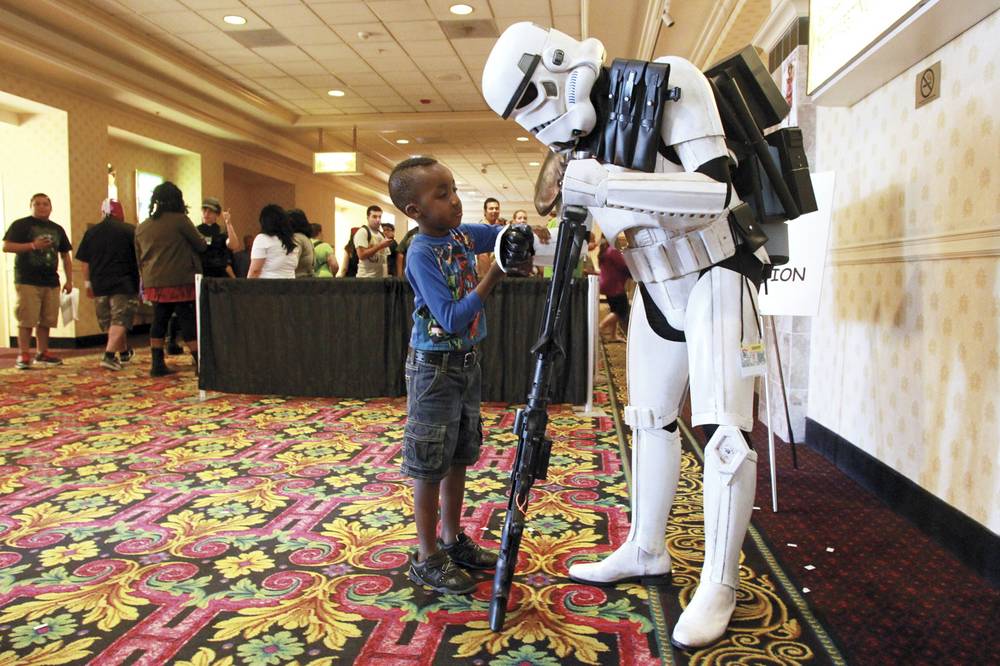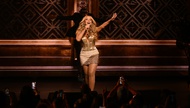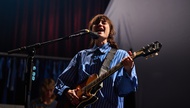Grant Morrison is a rock star. At least, he is among people who closely follow comic books, and at Body English inside the Hard Rock this past Friday, the writer behind such acclaimed series as Batman Inc., All-Star Superman and The Invisibles took a stab at being an actual rock star. It was the opening night of MorrisonCon, a three-day event dedicated to all things Morrison, attended by a thousand or so of his most dedicated (and well-heeled, since tickets started at $499) followers. More than an hour past the scheduled start time, Morrison took the stage along with Gerard Way and James Dewees of My Chemical Romance, greeted by huge cheers from audience members, not one of whom was dressed as a superhero. Morrison delivered a 30-minute epic poem about the apocalypse in Las Vegas (or something like that), as Way and Dewees played ambient soundscapes on their keyboards. It was completely, ridiculously pretentious, like some open-mic slam poetry night at a progressive liberal-arts college, but it lived up to the event’s promise: a once-in-a-lifetime experience.
The rest of MorrisonCon wasn’t nearly as revolutionary, and despite its lofty pretensions, it actually paled in comparison to a much humbler (and cheaper) comics-related event a few blocks down the road. Yes, despite not having hosted a full-scale commercial comic-book convention since 2003 (the year of a disastrously under-attended event at Mandalay Bay), Vegas was somehow home to two separate comic-cons in one weekend. MorrisonCon was all about elevating comics as an art form and social movement, while the Las Vegas Comic Expo at the Riviera was a celebration of pure pop-culture geekery.
On Saturday morning at the Riviera Convention Center, there was a reported wait of 45 minutes to buy tickets for the Comic Expo, and organizers estimated attendance at 6,500-7,000 over the course of the event’s two days. On the convention floor, a steady stream of fans wandered past booths and tables featuring vendors and creators, and nearly everyone I talked to expressed a sort of bemused surprise that the event was turning out so well. Writer Joshua Hale Fialkov, who works steadily for DC Comics and Marvel Comics as well as on his own independent creations, described attendance at the event by his fellow professionals as “an act of faith” in veteran convention organizer Jimmy Jay, who served as the event’s director of operations, supporting founders Charles and Robert Lee.
The local comics community made a strong showing in the artists’ alley area, dominated by the Artist’s Comic Collective, whose members were promoting their work at eight different tables. That included ACC founding member Free Isabelo, who was at the convention pushing his creation Avenger Red. Isabelo said the Expo’s artists’ alley was “better than most I’ve seen.”
More
- Comic-cons
- MorrisonCon
- Las Vegas Comic Expo
That was the sentiment from other local artists, too. Estefania Rodriguez, who, along with her fiancé Arnel Baluyot makes up the art team Ninjabot, said that she “came to support the nerd community” and was surprised at the turnout. Artist Popeye Wong had found out about the Expo only three days earlier but was doing brisk sales of his eye-catching pinup art.
MorrisonCon was about a different kind of community, a gathering of fans enraptured by Morrison’s cult of personality, promising a transcendent experience rather than just an afternoon perusing tables of comic books. The event was touted as “maximum rock ’n’ roll, chaos magic, mind-bending esoterica, sharp suits, surprise guests and once-in-a-lifetime performances,” but following Friday night’s extravaganza, it was pretty much just a pleasant comic-book convention, dominated by panel discussions mostly indistinguishable from programming at any other decent-size convention (nearly a third of MorrisonCon’s special guests, including Morrison himself, are scheduled to appear at the New York Comic-Con just two weeks later). A reporter for comics website Comic Book Resources told me about a fan she encountered on the first day, primed for a literally magical experience, who two days later acknowledged that the event had turned out to be pretty mundane.
For many people, though, just being in close proximity to Morrison and other revered creators (including Jim Lee, Robert Kirkman, Frank Quitely and Jason Aaron, among others) was clearly worth the money and the trip. Fans asking questions at panels frequently thanked Morrison and the organizers for putting on such a wonderful event. At one panel on Sunday afternoon, two separate questioners declared their intentions to get tattoos commemorating the weekend, asking Morrison and Quitely for suggestions of what imagery from their work would be most appropriate.
It’s unlikely that anyone will get a tattoo to commemorate the Las Vegas Comic Expo, but attendees came away with much of the same advantages as those who paid more than 10 times as much to go to MorrisonCon. One of the most important features of MorrisonCon was its easy access to creators, with fairly short lines for signings and the near guarantee of being able to ask a question at a panel. The admission price was like a really expensive line pass, a way to ensure that Morrison would absolutely, positively sign your X-Men or Batman comics. But at the Expo, lines to meet popular creators like J. Scott Campbell and Hellboy’s Mike Mignola were just as short and moved just as quickly. And just like a typical convention, MorrisonCon limited signings to three items per person, with a three-minute limit on time spent with the creators.
On Sunday morning at the Comic Expo, creators Joshua Hale Fialkov, Jim McCann, Brian Buccellato and Mike Costa appeared on a panel about producing independent comics, telling their own stories about creating, financing and marketing original stories outside of the big two comics publishers (DC and Marvel). “We’re going to talk about comics, and they’re going to talk about darts,” Fialkov joked in reference to the very loud darts tournament being held in an adjacent meeting room, which could be heard during pretty much every panel.
The four creators talked about the difficulties and rewards of working on creator-owned comics, emphasizing their passion and personal connection to the work even in the face of overwhelming difficulties. “You have to face the reality that most people are going to the store to pick up their Avengers or Justice League,” Costa said. “People have no reason to buy your book.”
Yet all four encouraged the aspiring writers and artists in the audience to pursue their ideas, highlighting the supportive community of comic-book creators. “We want other people to succeed,” McCann said, offering suggestions on ways for writers and artists to connect with each other, and inexpensive avenues to get content to audiences before attempting to pitch a major publisher.
Just a few hours later at MorrisonCon, writer Jonathan Hickman gave nearly the exact same advice to a packed room of fans, all just as eager to be encouraged and motivated to pursue their own creations. Hickman’s The Manhattan Projects and McCann’s Mind the Gap are two of the best-selling books from top indie publisher Image Comics, and both writers had valuable wisdom to share. Later in the day at MorrisonCon, one fan got up to the microphone to announce that he had been inspired to organize an anthology of work from fellow fans he had met at the convention. That’s what Morrison was really selling: inspiration.
At the Las Vegas Comic Expo, people showed up in elaborate costumes, children ran around laughing, and vendors peddled boxes of comic books to eager collectors. At MorrisonCon, I spotted just one person (a lonely Catwoman) in costume, there were no children, and only high-end original art was available to buy. But in both cases fans had the chance to be inspired, to celebrate their passions and come away reinvigorated. The success of the Comic Expo bodes well for the prospect of it becoming an annual event; as for MorrisonCon, well, it was billed as a “once-in-a-lifetime” experience, and that level of hype tends to have a short shelf life.







Previous Discussion: